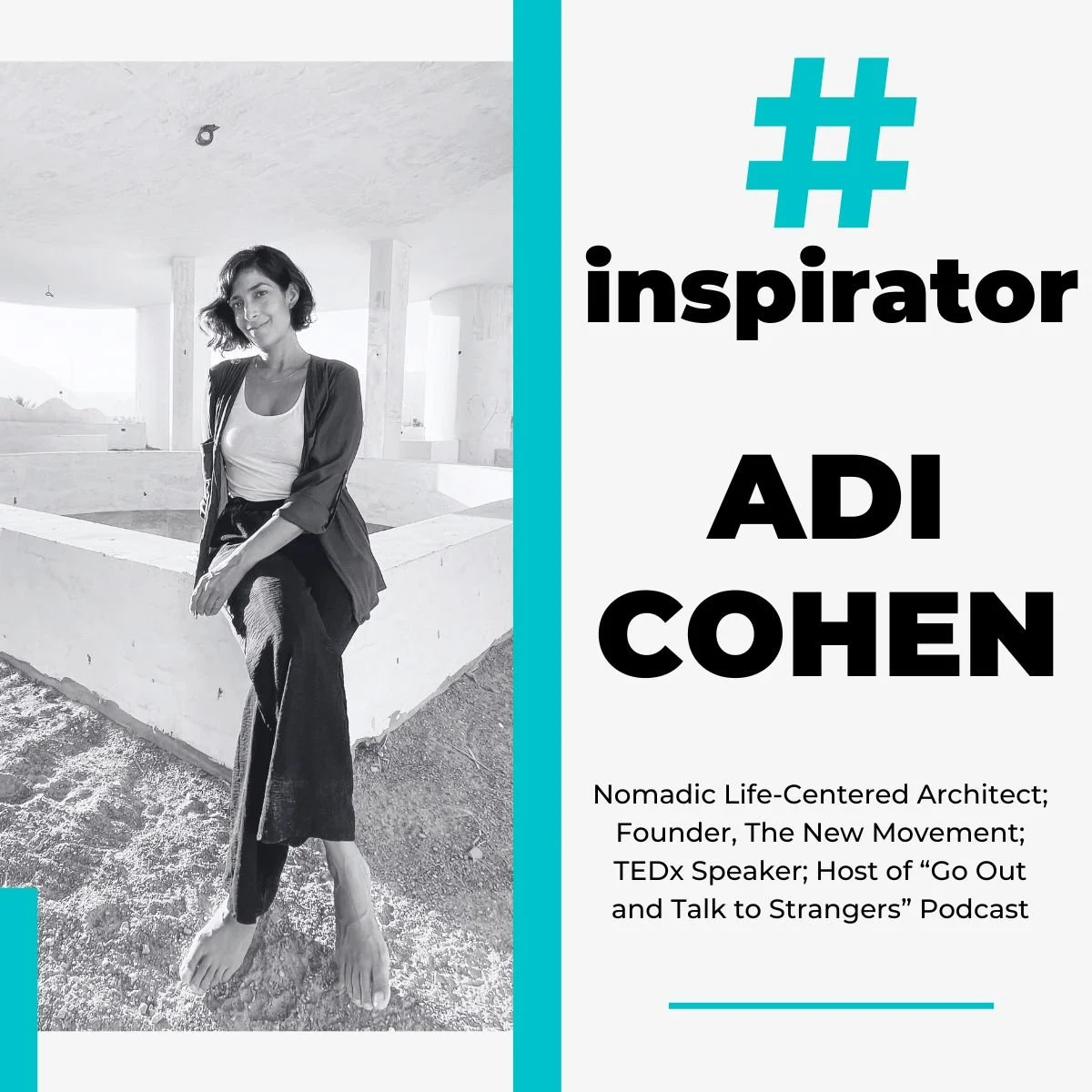Adi Cohen
on Nomadic Architecture and Life-Centered Design
Any place can become a “sanctum for the soul.”
But is there such a thing as the ideal environment?
How does it look? How does it feel?
These questions invite a curious and honest exploration of the transformative power of space. But Adi Cohen asked herself one more: Is there only one way to be an architect?
For Adi, architecture is much more than creating beautiful buildings: https://lnkd.in/dEQPWHkK
It’s a way of creating freedom. An invitation to be alive, to dance with life instead of waiting to live fully: “Architecture is a life-centred act. It’s having the clarity to know what’s important to you and how you want to live your life. A way of curating your life to support you in becoming your best self."
Back when she worked as a traditional architect in Tel Aviv, Adi realized something was missing. Ten-hour work days behind a desk left little room for the kind of creative, connected life she longed for. Architecture had to mean more - it should take her places to learn from global cultures and truly inspire her work.
She made a bold choice: to embark on a journey to wander and wonder, searching for that life she was yearning for: “I sold all my stuff and got a one-way ticket to Japan! That decision changed my life. I wandered around, surrounded in magic while working remotely.”
Those precious days taught her that architecture is an art form deeply rooted in human behaviour and well-being. Her design philosophy now blends principles from neuroarchitecture, biophilia and human-centered design, bridging ancient traditions with emerging technologies. Adi is now a Nomad Architect, TEDx speaker, and the founder of The New Movement, a mobile architecture studio designing transformative spaces worldwide. She also hosts the podcast “Go out and talk to strangers”, where she speaks with pioneers reimagining how we live, work, and connect.
Every project she creates needs to genuinely answer these questions: How do spaces affect us as humans? What impact does design have on our quality of life? How can architecture connect people to place, physically and emotionally? She is a collector of moments, knowledge and inspiration. Each new place she visits gently reveals its architectural and cultural DNA, all that makes it distinct: “This is my creative fuel, the beauty I wish to create. Each human has a unique memory palette, a summary of experiences, memories and desires. There is no formula, just an exploration to understand the psyche. I seek Wabi Sabi, perfection in imperfection. A quest for a sophisticated simplicity, a weaving of stories into space.”
Read Adi Cohen’s answers for Inspirators and remember to immerse yourself in all the spaces that inspire, nurture, and transform you!
Thank you, Adi, for being a Life-Centred Architect!
#INSPIRATORS QUESTIONNAIRE
Name: Adi Cohen
Company / Institution: The New Movement
Title: Founder
Website: Thenewmvt.com
LinkedIn profile: https://www.linkedin.com/in/adi-cohen-architect/
Country of origin: Israel
Country you currently live in: Nomadic / Norway
Your definition of Regeneration: Regeneration is deep listening with all of our senses to the wider web of life. It’s an ongoing dialogue, one that honors all life forms, seen and unseen, and recognizes that we are in constant relationship with the environments we shape and inhabit. It is not just about sustainability or restoration; it is about designing spaces, systems, and cultures that enable all beings to thrive in reciprocity.
Main business challenge you face: Scaling impact while staying true to the depth and integrity of regenerative design. It’s about moving beyond isolated projects to creating ripples - shifting mindsets, influencing industries, and embedding life-centered principles into the core of how spaces are conceived and built.
Main driver that keeps you going: The vision of environments that nourish both people and the planet. Spaces that breathe, evolve, and celebrate the aliveness of the world. I am fueled by the creative process—shaping environments that invite a deeper connection to nature, self, and others. The possibility of architecture that is not just about structures but about experience, presence, and transformation.
The trait you are most proud of in yourself: Endless curiosity. The ability to see the world as an unfolding question rather than a fixed set of answers. Curiosity keeps me in motion, seeking new perspectives, new relationships, and new ways of designing that are not just inspired by nature but are an extension of it.
The trait you most value in others: The ability to dream big - and then take the steps to bring those dreams to life. Visionaries who are not afraid to challenge conventions, who see possibilities where others see limitations, and who are willing to experiment, adapt, and persist in bringing regenerative futures into being.
Passions & little things that bring you joy: Tai chi, hot chocolate, meditation, walking barefoot.
The Inspirators who determined you to take the regenerative path: Those who embody relational wisdom - Indigenous knowledge keepers who see the land as a living being, architects who design with and for life, thinkers who challenge us to see beyond human-centered narratives. The people I meet on my journey, whose ways of being offer glimpses into alternative futures.
A starting point for companies or professionals that are beginning the regeneration journey: Start by asking questions you don’t have the answers to - and wait. Allow space for the unknown. Engage in deep listening, not just to people but to place, to patterns, to the wisdom embedded in nature. Shift from a mindset of control to one of co-evolution.
Most used and abused clichés in sustainability that bother you: The idea that we must choose between planetary well-being and human well-being. It’s a false dichotomy: our well-being is inseparable from the health of the ecosystems we depend on. Regeneration is not about sacrifice but about rediscovering ways of living that enrich life rather than extract from it.
An honest piece of advice for young people who lose hope: Go offline. Go into nature for five days. Observe, listen, and see what happens next. The natural world holds a wisdom that modern life often drowns out - patterns of resilience, interdependence, and quiet adaptation. If you feel disconnected, travel - not just physically but mentally, exposing yourself to cultures and perspectives that remind you of what’s possible.
Books that had a great impact on you / Must-Reads for any regenerative professional:
· Sand Talk by Tyson Yunkaporta
· All books by Christopher Alexander
Music that makes you (and your heart) sing: Brazilian Samba, especially the oldies!
Places you travelled to that left a mark on you: I’ve traveled far and wide in the past 7 years of my nomadic journey. I find that moving between vibrant cities and remote landscapes has shaped my perspective - seeing how different cultures relate to space, time, and nature.
Japan, in particular, left a deep impression - its seamless integration of built and natural environments, the reverence for seasonality, and the philosophy of ma (negative space, the space between things) that invites presence and contemplation.
Trends in Regeneration we should keep an eye on:
· The fusion of ancestral wisdom with advanced science: learning from nature’s intelligence while applying cutting-edge research.
· Bioregionalism: designing for place-specific resilience rather than one-size-fits-all solutions.
· Spaces that measure impact not just in energy efficiency but in human and ecological well-being: architecture that supports mental, emotional, and biological flourishing.
Events we should attend / Best places for networking (online or offline):
If you get the chance, attend an unconference! An immersive gathering where the agenda isn’t predefined, but rather co-created by the participants. These spaces foster genuine dialogue, collaboration, and the exchange of ideas in a whole other way.
Reasons to feel optimistic about our future in 2030: The regenerative movement is no longer at the fringes - it is gaining traction across industries. More architects, designers, and communities are recognizing that our built environments can be places of healing rather than depletion. The shift from extraction to regeneration is happening—not fast enough, but undeniably.
Reasons to feel pessimistic about our future in 2030: If we continue to prioritize short-term profit over long-term planetary well-being, we risk deepening ecological and societal fractures. The challenge is not a lack of solutions but a resistance to shifting paradigms.
Regenerative Leadership qualities much needed today: Deep listening, humility, courage, relational thinking.
The Inspirator(s) you are endorsing for a future edition:
· Michal Ziso
· Britt Wray
The quote that inspires you:
“Although many of us think of ourselves as thinking creatures that feel, biologically we are feeling creatures that think.” (Jill Bolte Taylor)
Your quote that will inspire us:



